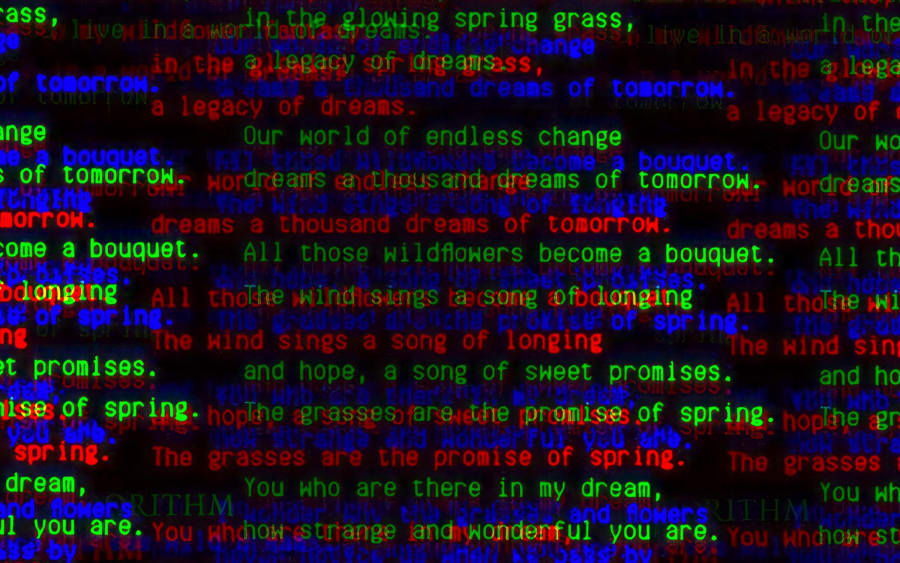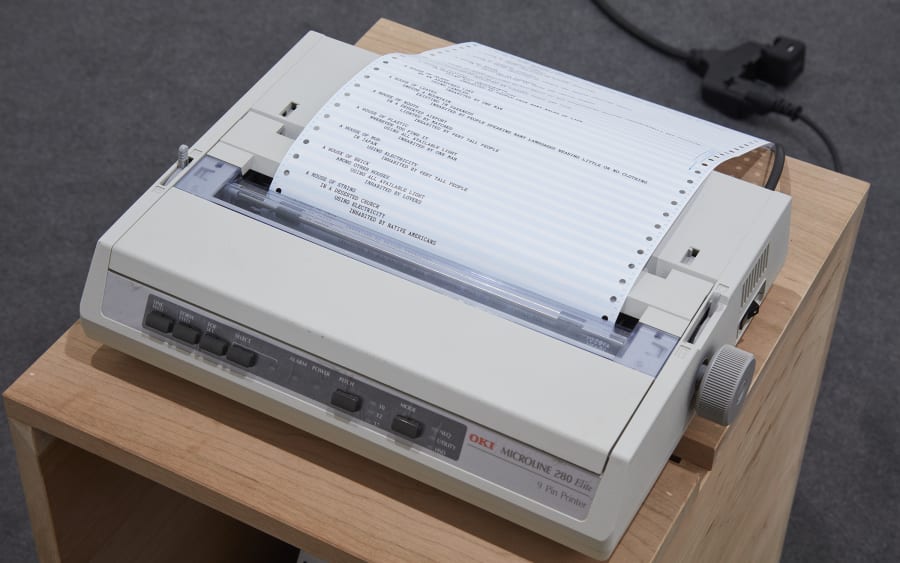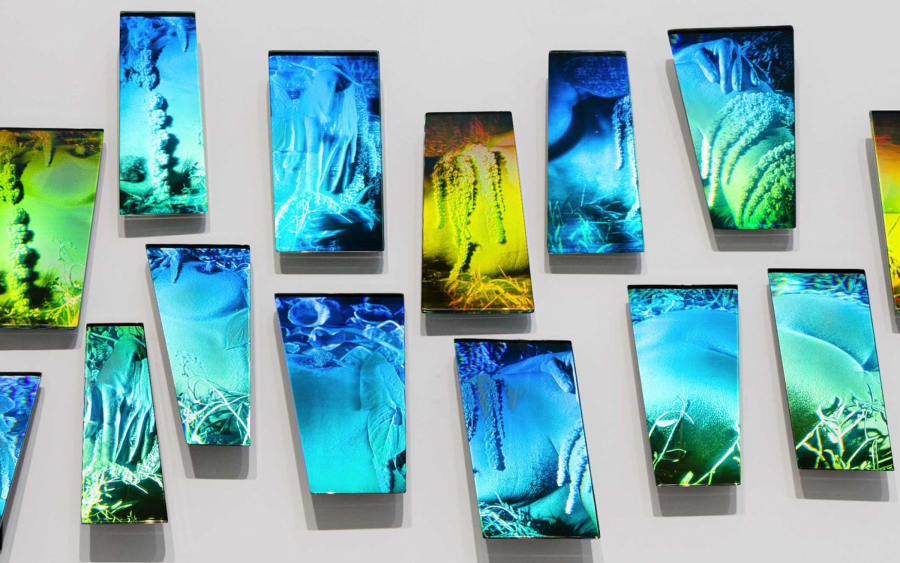It was during their art-and-tech residency at CERN, Switzerland, in 2022, that the artist duo Dorota Gawęda and Eglė Kulbokaitė first noticed how closely their approach to making art mirrored scientific practice. ‘In our work, there’s always a need to question binary understandings of the world, to look for in-betweenness,’ Gawęda reflects. ‘And when you’re dealing with something as complex as quantum physics, you’re trying to look beyond what’s visible. The deeper you go, the more you realize it is a place that exists beyond binary logic.’
For two months, with an additional month at Hangar in Barcelona, the duo went through an intense schedule of talks and discussions with leading theoretical and experimental physicists. CERN – home to the Large Hadron Collider, which is used to investigate the origins of the universe and quantum phenomena – has carried out some of the most advanced research in the world, and the artists enjoyed astonishing access to facilities, live experiments, archives, image databases, and libraries. ‘The experience influenced our work a lot,’ Kulbokaitė says, thinking back to their time there, ‘but not in a material or tangible way, more in how we think.’
Ever since the American research and development company Bell Labs (later Nokia Bell Labs) and E.A.T. (Experiments in Art and Technology) began bringing artists together with engineers and scientists in the 1960s, art-and-tech residencies have played a vital role in exploring the intersection of art, science, and technology. Central to this was the work of Lillian F. Schwartz (1927 – 2024), an American artist considered a pioneer of computer-mediated art. Affiliated with Bell Labs from 1969 to 2002, she shifted perceptions of computers – from being seen merely as calculators they became recognized as instruments for artistic inquiry, perceptual experiment, and cultural critique.
‘She was hugely inspiring,’ recalls Sougwen Chung, a contemporary artist whose work focuses on human-machine collaboration. Chung first met Schwartz around the time Chung was part of the 2018 revival of E.A.T. at Bell Labs in partnership with New Museum. ‘She was groundbreaking – pioneering the use of imaging systems at Bell Labs.’ Chung, who was selected for the one-year residency program along with four other artists and collectives, was struck by the long-term vision of the American research and development company credited with inventing the laser. ‘They weren’t focused on immediate products – they researched technologies with a 10-year horizon, from sensory systems to wireless tech.’
‘If I look back at the residency,’ Chung continues, ‘the experience was hugely catalytic, especially talking with the renowned researchers. But artists nowadays wear many hats – we’re less reliant on engineers to realize our ideas.’ In Schwartz’s era, the line between toolmaker and tool-user was more clearly drawn, whereas Chung developed and built their own robotic systems, learning the technology as they went along. It’s why Chung believes artists should be more involved in shaping technology. ‘Too often the conversation is framed as what can technology do for artists? But artists can bring vital perspectives to technology itself.’
For Giulia Bini, who has led the residency program at CERN since May this year, the exchange between artists and scientists works both ways. ‘CERN itself has a mission,’ she explains. ‘It’s not only the European Centre for Particle Physics, but also an institution for open science. And artists help expand the dialogue around that mission. But we’re not talking about artists communicating science or playing a functional role. They’re here to explore a new field of knowledge, and that exploration can also impact their practice in numerous ways – philosophical, conceptual, aesthetic.’
CERN’s residencies vary widely – some last one to three weeks, others span two months, and some projects unfold over years, with artists returning repeatedly. Among the international programs run by Arts at CERN, Connect is the global framework conducted with Pro Helvetia, the Swiss Arts Council, while Collide, the program Gawęda and Kulbokaitė participated in, is an international open call and the institution’s flagship residency, with the selected artists receiving a stipend, a stay at CERN and a partner city and cultural institution, and a production budget to allow the realization of work begun during their residency.
That long-term approach matters and Gawęda and Kulbokaitė, three years on, are only now developing a video project based on letters exchanged between Wolfgang Pauli – a key figure in the development of quantum mechanics – and the psychoanalyst Carl Jung. ‘We see our time there as more of a research residency. It takes time to process all that input,’ Gawęda says. ‘It was a great experience,’ Kulbokaitė adds, as she considers the prospect of doing another art-and-tech residency, ‘but technology is just one part of our work and not the center, so it would really depend on the opportunity.’
For artists for whom technology plays a more substantial role in their work, such as the New York-based Emily Xie, who is just coming to the end of a residency at the Toledo Museum of Art, Ohio, and its experimental technology and arts division, TMA Labs, a program like this can expand an art practice in entirely new directions. ‘When you’re always producing works for a gallery, you can feel compelled to keep producing in the style you’ve become known for. But in a residency the point is to broaden your practice.’
Xie, a generative artist who often creates algorithmic systems inspired by textiles and traditional crafts, began experimenting with glass during the year-long program. ‘On screen everything feels possible,’ she says. ‘You can make pixels do whatever you want. But with something physical like glassblowing, you have to deal with physics – there are constraints.’ Participating in the residency has allowed her to work with new materials and forms: ‘I wanted more ways to combine the digital and the physical, to combine algorithms with traditional art-making methods. The glass studio team at Toledo were amazing in translating these into workable objects. They knew what was physically possible.’
For the Berlin-based artist duo Holly Herndon and Mat Dryhurst, recently announced as recipients of the 2026 Villa Albertine residency in San Francisco, it was the program’s proximity to Silicon Valley that made it so appealing. ‘The residency has hubs all over the US,’ Herndon explains, ‘but San Francisco is where the AI capital is concentrated.’ For over a decade, Herndon and Dryhurst have explored collaborative approaches to AI, working with datasets as artistic partners. ‘This new wave of AI means being there in person matters,’ Herndon says. ‘You have to get a sense of what’s happening on the ground and have direct conversations with scientists, developers, and people working in capital.’
The incredible speed of technological change, advances in AI, and the ever-deepening entanglement of science and culture are why Bini believes art-and-tech residencies are so vital. ‘It’s imperative that artists have the space to focus on, and question, the implications of these developments. It’s not about art serving science. Instead, artworks can arrive at a synthesis, an aesthetic form of insight that science itself doesn’t always reach.’
Bini ran an art-science program at EPFL, the Swiss Federal Institute of Technology of Lausanne, before joining CERN, and in her regular meetings with scientists and researchers on topics such as AI and quantum mechanics she has become increasingly aware of a disconnect. ‘Many scientists feel the public is distant from their ideas. If artistic practice can help bridge that distance, residencies that embed artists within scientific institutions may be among the most productive sites of inquiry we have,’ she says, adding, ‘That’s what I value most about Arts at CERN and similar residency programs. They ultimately regard artistic research with the same seriousness as scientific research.’
Duncan Ballantyne-Way is a writer, editor, and art critic based in Berlin.
Caption for header image: Sougwen Chung, Omnia Per Omnia (with D.O.U.G._3), 2018. Courtesy of the artist.
Published on October 2, 2025.


